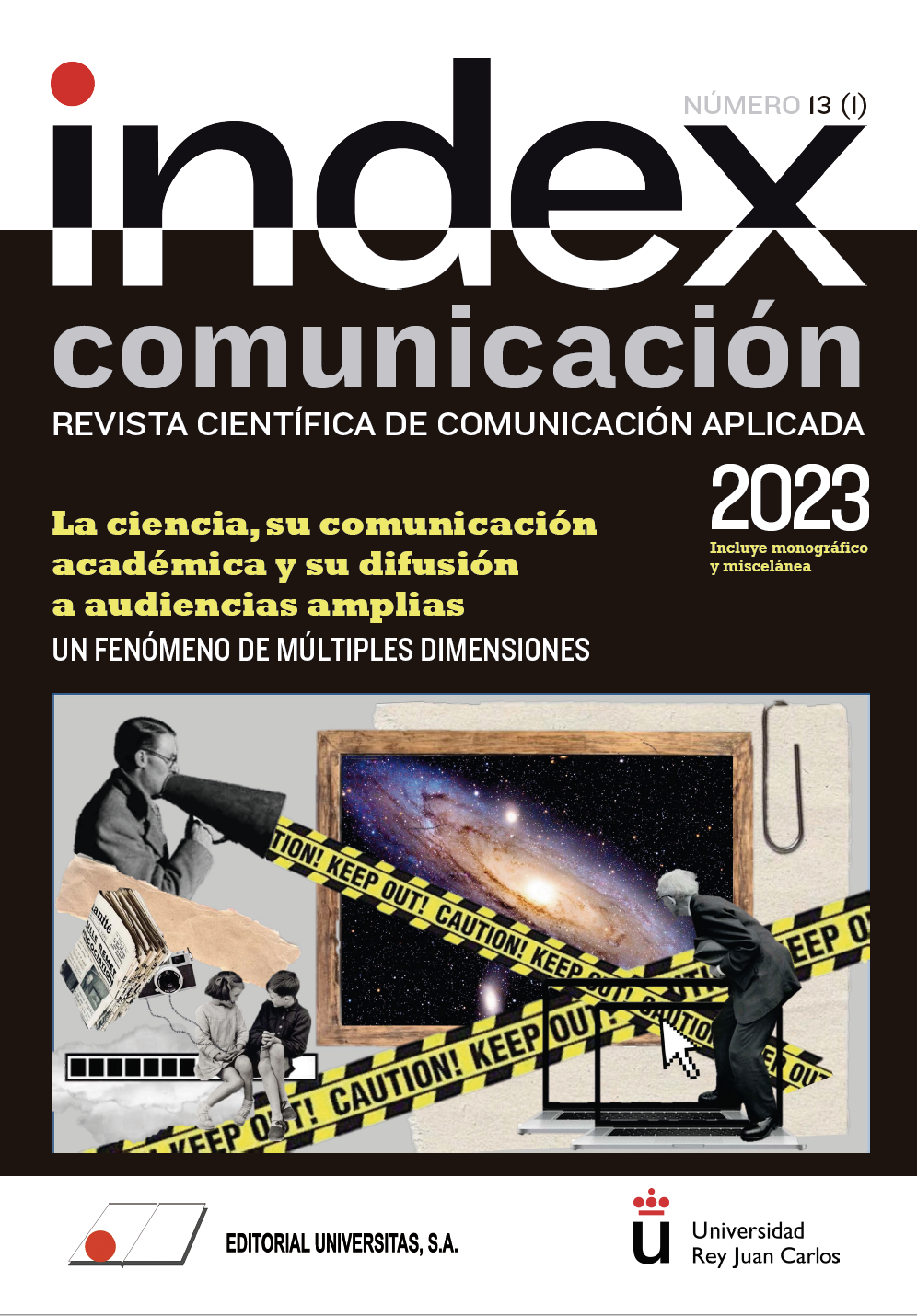Scholarly Communication: A Discipline That We Should be Promoted
DOI:
https://doi.org/10.33732/ixc/13/01ComuniKeywords:
Scholarly Communication, Academic Publications, Scientific Journals, Academic Databases, Open Science, University LibrariesAbstract
Scholarly communication is the name given to a wide field of activities linked to the very diverse ways in which the authors of academic works publish and disseminate their results. It includes tasks whose connections to this publication are not only direct, but also influence each other. These are the tasks of dissemination, treatment, analysis and information retrieval, such as those carried out by databases and other agents. But the issue goes even further and to these we must add other activities, equally interconnected, such as preservation and increased visibility, along with specialized actions carried out by university libraries. It is concluded that academic communication, despite its breadth and diversity (or precisely because of it), should be studied by a unified discipline that, thanks to a holistic vision, helps to overcome its main problems. This paper presents some of these problems and defends the need for both the field of activities itself and the discipline that studies them to receive a clearer and more determined impulse.
Metrics
References
ABADAL, E. (ED.) (2017). Revistas científicas: situación actual y retos de futuro. Edicions de la Universitat de Barcelona.
ACRL SCHOLARLY COMMUNICATION COMMITTEE. (2003). Scholarly Communication: Principles and Strategies for the Reform of Scholarly Communication: Issues Related to the Formal System of Scholarly Communication. College & Re-search Libraries News, 64(8), 526-547. https://doi.org/10.5860/crln.64.8.526
ANDERSON, R. (2018). Scholarly Communication: What Everyone Needs to Know. Oxford University Press.
ANGLADA, L., y ABADAL, E. (2018). ¿Qué es la ciencia abierta? Anuario ThinkEPI, 12(0), 292.
http://doi.org/10.3145/thinkepi.2018.43
BAIGET, T. (2020). Manual SCImago de revistas científicas. Creación, gestión y publicación. Ediciones Profesionales de la Información SL.
https://doi.org/10.3145/manual
BEEL, J., GIPP, B., y WILDE, E. (2010). Academic Search Engine Optimization (ASEO): Optimizing Scholarly Literature for Google Scholar & Co. Journal of Scholarly Publishing, 41(2), 176-190.
https://doi.org/10.3138/jsp.41.2.176
BOHANNON, J. (2016). Hate journal impact factors? New study gives you one more reason. Science, 6.
https://doi.org/10.1126/science.aag0643
BUNGE, M. (2013). La ciencia: su método y su filosofía. Laetoli.
CALLAWAY, E. (2016) Beat it, impact factor! Publishing elite turns against controversial metric. Nature, 535, 210–211. https://doi.org/10.1038/nature.2016.20224
CAMPOS, A., PEDRAZA-JIMENEZ, R., y CODINA, L. (2021). Comunicación efectiva de la ciencia, diseminación y explotación: actividades multiplicadoras del impacto en el sistema europeo de investigación e innovación. Universitat Pompeu Fabra, Departamento de Comunicación. Serie Digital Digidoc-EPI.
https://doi.org/10.3145/digidoc-informe6
CANTU-ORTIZ, F. J. (ED.). (2017). Research Analytics: Boosting University Productivity and Competitiveness Through Scientometrics. CRC Press.
CODINA L. (2021) What is a scientific article?: IMRaD and JARS: components and meaning. Universitat Pompeu Fabra, Medium Research Group.
http://hdl.handle.net/10230/47101
CODINA, L., y CORTIÑAS, S. (2022). ¿Autoplagio o texto reciclado? Algunas implicaciones inesperadas de la digitalización de la ciencia. Anuario ThinkEPI, 16.
https://doi.org/10.3145/thinkepi.2022.e16a16
HAMES, I. (2007). Peer Review and Manuscript Management in Scientific Journals: Guidelines for Good Practice. Blackwell.
MARTÍN-MARTÍN, A., ORDUNA-MALEA, E., THELWALL, M., y LÓPEZ-CÓZAR, E. D. (2018). Google Scholar, Web of Science, and Scopus: A systematic comparison of citations in 252 subject categories. Journal of informetrics, 12(4), 1160-1177.
https://doi.org/10.1016/j.joi.2018.09.002
MORALES-VARGAS, A., y CODINA, L. (2019). Atributos de calidad web para repositorios de datos de investigación en universidades. Hipertext.net, (19), 49-62.
https://doi.org/10.31009/hipertext.net.2019.i19.04
MOSKOVITZ, C. (2021). Standardizing terminology for text recycling in research writing. Learned Publishing, 34(3), 370-378.
https://doi-org/10.1002/leap.1372
ORTÚZAR, G. (2014). Publicación digital en las universidades y el nuevo papel de las bibliotecas. Anales de la Universidad de Chile, (6), 175-186. https://doi.org/10.5354/0717-8883.2014.31831
REPISO, R., ORDUÑA-MALEA, E., y AGUADED, I. (2019). Revistas científicas editadas por universidades en Web of Science: características y contribución a la marca universidad. Profesional de la información. 28(4) https://doi.org/10.3145/epi.2019.jul.05
REPISO, R., TORRES-SALINAS, D., y AGUADED, I. (2019). La gestión de revistas: mérito de transferencia universal. Justo y necesario. Anuario ThinkEPI, 13. https://doi.org/10.3145/thinkepi.2019.e13e03
ROVIRA, C., GUERRERO-SOLÉ, F., y CODINA, L. (2018). Received citations as a main SEO factor of Google Scholar results ranking. Profesional de la Información, 27(3), 559–569.
https://doi.org/10.3145/epi.2018.may.09
VESNIC-ALUJEVIC, L. (2014). Peer Review and Scientific Publishing in Times of Web 2.0. Publishing Research Quarterly, 30(1), 39-49.
https://doi.org/10.1007/s12109-014-9345-8
WEBER-WULFF, D. (2019). Plagiarism detectors are a crutch, and a problem. Nature 567, 435.
https://doi.org/10.1038/d41586-019-00893-5
WRIGHT, G. (2019). Library Science and Scholarly Communication. College Publishing House.
WU, J. (2011). Improving the writing of research papers: IMRAD and beyond. Landscape Ecology, 26, 1345–1349.
Published
How to Cite
Issue
Section
License
Copyright (c) 2022 Lluís Codina

This work is licensed under a Creative Commons Attribution-NonCommercial 4.0 International License.
Authors who submit to this journal agree to the following terms:
Authors retain copyright and ensure the magazine's right to be the first publication of the work as licensed under a Creative Commons Attribution-NoComercial 4.0 International License that allows others to share the work with an acknowledgment of authorship of the work and the initial publication in this magazine, with no commercial purpose.
Authors can establish separate additional agreements for non-exclusive distribution of the version of the work published in the magazine (for example, to an institutional repository or publish it in a book), with an acknowledgment of its initial publication in this journal.
It allows and authors are encouraged to disseminate their work electronically (eg, in institutional repositories or on their own website) prior to and during the submission process, as it can lead to productive exchanges, as well as a citation more early and most of the published work (See The Effect of Open Access).















